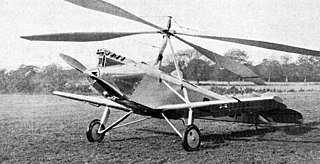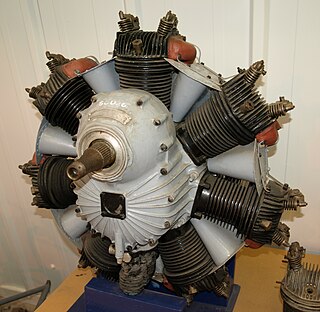Related Research Articles

The Cierva C.30 is an autogyro designed by Juan de la Cierva and built under licence from the Cierva Autogiro Company by A V Roe & Co Ltd (Avro), Lioré-et-Olivier and Focke-Wulf.

The Pitcairn OP-1 was the first rotary-wing aircraft to be seriously evaluated by any of the world's major air forces. The machine was not a helicopter, nor an airplane, but an autogyro. Pitcairn's model was never put into production for any military.

The Cierva W.11 Air Horse was a helicopter developed by the Cierva Autogiro Company in the United Kingdom during the mid-1940s. The largest helicopter in the world at the time of its debut, the Air Horse was unusual for using three rotors mounted on outriggers, and driven by a single engine mounted inside the fuselage.

The Fairey FB-1 Gyrodyne is an experimental British rotorcraft that used single lifting rotor and a tractor propeller mounted on the tip of the starboard stub wing to provide both propulsion and anti-torque reaction.
The Cierva Autogiro Company was a British firm established in 1926 to develop the autogyro. The company was set up to further the designs of Juan de la Cierva, a Spanish engineer and pilot, with the financial backing of James George Weir, a Scottish industrialist and aviator.

The Pobjoy Niagara is a British seven-cylinder, air-cooled, radial, aero-engine first produced in 1934. The design ran at higher speeds than conventional engines, and used reduction gearing to lower the speed of the propeller. This led to a noticeable off-centre mounting for the propeller. The Niagara was a popular engine for light and experimental aircraft, well regarded due to its small diameter, smooth operation, low noise and innovative engineering.

The Cierva C.8 was an experimental autogyro built by Juan de la Cierva in England in 1926 in association with Avro. Like Cierva's earlier autogyros, the C.8s were based on existing fixed-wing aircraft fuselages – in this case, the Avro 552.

The Cierva C.17 was a British experimental autogyro built by Cierva Autogiro Company in England in 1928, in association with Avro. It was an attempt to build upon the successful Cierva C.8 design using the smaller, more streamlined fuselage of an Avro Avian IIIA as a starting point. The type was found to be underpowered, and when the first attempt at fitting a more powerful engine still did not result in acceptable performance, the design was abandoned.

The Cierva C.19 was a 1930s British two-seat autogyro, designed by Spanish engineer Juan de la Cierva. It was built by Avro as the Avro Type 620. It proved to be the most successful and widely produced of the early de la Cierva designs.

The Pobjoy R is a British seven-cylinder air-cooled radial aircraft engine designed and built by Pobjoy Airmotors. Introduced in 1926, it was a popular engine for ultralight and small aircraft in the 1930s. A notable feature of the Pobjoy R was the propeller reduction gear which allowed the small engine to operate at more desirable higher speeds.
The Landgraf H-2 was an American single-seat twin-rotor helicopter designed by Fred Landgraf and built by the Landgraf Helicopter Company of Los Angeles, California. Although awarded a development contract by the United States Army, it was not developed and was overtaken by more advanced designs.

The Kellett KD-1 was a 1930s American autogyro built by the Kellett Autogiro Company. It had the distinction of being the first practical rotary-wing aircraft used by the United States Army and inaugurated the first scheduled air-mail service using a rotary-wing aircraft.

The de Havilland C.24 was a two-seat autogyro built by de Havilland at its Stag Lane works in England in 1931

The Pitcairn PCA-2 was an autogyro developed in the United States in the early 1930s. It was Harold F. Pitcairn's first autogyro design to be sold in quantity. It had a conventional design for its day – an airplane-like fuselage with two open cockpits in tandem, and an engine mounted tractor-fashion in the nose. The lift by the four-blade main rotor was augmented by stubby, low-set monoplane wings that also carried the control surfaces. The wingtips featured considerable dihedral that acted as winglets for added stability.
The Comper Kite was a single-engined, two-seat touring monoplane built in the UK, derived from the contemporary Comper Streak racer. Only one was built.

British Salmson aero-engines refers to a series of small French designed, air-cooled radial aero engine that were produced by British Salmson Aero Engines Ltd, under license from Société des Moteurs Salmson, in Great Britain during the late 1920s and 1930s.

The Autogiro Company of America AC-35 was an early attempt to make a roadable aircraft in the United States during the 1930s. Although it was successfully tested, it did not enter production; a 1960s attempt to revive the aircraft in a non-roadable version also failed to achieve success.
The Cierva C.29 was a five-seat British cabin autogyro built in 1934 as a joint venture between Westland Aircraft and Cierva. The rotor system and rotors were designed by Cierva and the fuselage by Westland. It was powered by a 600 hp (447 kW) Armstrong Siddeley Panther II engine with a two-bladed tractor propeller; the engine also drove the three-bladed rotor via a clutched shaft. The C.29 suffered from ground resonance during ground running and was not flown. It was later acquired for evaluation by the Royal Aircraft Establishment but it was unable to cure the resonance problem and the autogyro was scrapped in 1939.
The Westland CL.20 was a two-seat autogyro designed and built by Westland Aircraft between 1934 and 1938. One flying prototype and six airframes were built, which had control problems and insufficient lift. Before these problems could be solved the programme was abandoned and the prototype was scrapped in 1938.

The 1933 experimental Pitcairn PA-22 was one of the first wingless autogyros. It was controlled by movement of the rotor plane rather than the usual control surfaces, though initially the much modified lone example retained rudders as a precaution.
References
- ↑ Stingray. "Comper-Cierva C.25 / G.31/1 - Stingray's List of Rotorcraft". sites.google.com. Retrieved 5 April 2020.
- ↑ Riding, Richard (June 1989). "Cierva C.25 - British pre-war lightplanes No 6". Aeroplane Monthly: 374–376.
- ↑ Young, Bill. "Cierva C.25 Blueprint". Blueprints.com. Retrieved 5 April 2020.